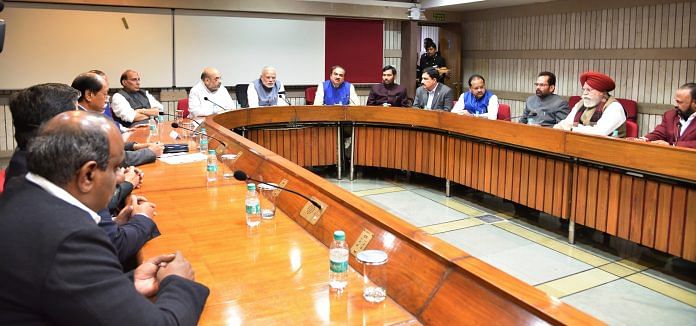Nineteen states have NDA governments, but the partners have lost their bargaining power because the survival of Modi government does not depend on them.
In 1989, when the BJP won 85 seats in the Lok Sabha polls, there were expectations in political circles that perhaps the country was moving towards a two-party system. This did not happen. When the National Democratic Alliance (NDA) was formed in 1998, and the United Progressive Alliance (UPA) in 2004, there was speculation that India will now have an era of two-front politics. Just when a consensus was emerging that the coalition era had come to stay, the BJP in 2014 won a majority on its own, 30 years after the Congress last managed it.
Interestingly, Congress leader Ahmed Patel claims that there is no UPA now. It was formed for the Congress-led government at the Centre, and is now only a loose front. Thirteen parties, including the DMK, NCP, RJD, and JD (U), were pre-poll partners in 2014. The Left parties had parted company in 2008 on the issue of the Indo-US nuclear deal.
As for the NDA, it has had a roller coaster ride in the past two decades. Growing on anti-Congress sentiment, it remained in power from 1998 to 2004, and again since 2014.
After he became the prime minister-elect in 2014, Narendra Modi lauded the role of allies in his victory speech. Even though the BJP had a majority of its own, he gave his allies representation in his cabinet.
Four years later, what does NDA stand for? It has expanded. Nineteen states have NDA governments, but the partners have lost their bargaining power, because the survival of Modi government does not depend on them.
The Shiv Sena bluntly says that the NDA is almost defunct. NDA meetings are rare. Although former Prime Minister Atal Bihari Vajpayee is still chairman of the NDA, he is not available. L.K. Advani is the co-chairman of the NDA, but he has been sidelined by his own party.
The allies had expressed their dissatisfaction last year when they had their second NDA meeting ahead of the presidential polls in July. BJP chief Amit Shah promised them that there would be more consultations, and things were smoothed over. But the partners are still waiting.
Another major grouse is that there is not much power sharing. The Shiv Sena and Akali Dal were expecting heftier portfolios when Modi reshuffled his cabinet. Even JD(U) chief Nitish Kumar was hoping for cabinet berths for his party last September.
Akali Dal MP Naresh Gujral said: “None of the allies were offered governorships, vice-chancellorships, or bank director posts. This is annoying. In a coalition, every party feels it should be given respect.”
Partners like Andhra Pradesh chief minister Chandrababu Naidu and former Punjab chief minister Parkash Singh Badal have expressed their dissatisfaction over the fact that the Centre was not giving them more funds. PDP chief Mehbooba Mufti wants more space to function in Jammu and Kashmir.
Parties such as Shiv Sena fear the speed with which the BJP is expanding, and are worried that their voters might shift to the BJP. The same is the case with the TDP. The expansion plan of the BJP in the south, and also the east, might be at their expense. As part of its strategy for the 2019 Lok Sabha polls, the BJP has set its sights on about 115 seats across the country which it has never won in the past.
The BJP must address the concerns of its partners. Is it serious about the NDA? It is not as if the BJP can totally ignore the other parties, because it needs their support in the Rajya Sabha, where the NDA is in a minority. The partners are flexing their muscles because the polls are nearing. The BJP has come this far after being termed an untouchable not too long ago.
In 1998, Vajpayee and Advani had stitched together a coalition with 24 partners. But this came at a price, as within a year, AIADMK supremo Jayalalithaa pulled down his government. Even during the tenure of the Vajpayee coalition, there were some murmurs, but they were not as shrill as they are now.
The NDA has been a revolving door for parties like Trinamool Congress and DMK. The NDA continued after 2004 because some of them like the TDP, the Shiv Sena, the Shiromani Akali Dal and other anti-Congress parties had nowhere to go. The BJP is confident the allies will not break the NDA.
“Obviously everybody is upset. But we hope that this will change as elections are coming. The BJP needs us and we need the BJP,” said Naresh Gujral.
It is likely that nearer the 2019 poll, the BJP will begin to mollify them, because it may be staring at the possibility of a reduced majority.



